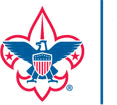The Eagle Scout Binder
Once you have completed your Eagle project, filled in the application (including a statement of ambition and life purpose and list of accomplishments), verified the dates for all your rank advancements and merit badge completions, it’s time to put it all together into an Eagle binder.
What is an Eagle binder you ask? I asked the same thing too, because it’s not discussed in any of the NCAC Eagle resources. So I asked our District Eagle Reviewer, Kurt Rausch.
Mr. Rausch explained that the binder is a way to make sure you have everything ready for your Eagle Board of Review and that all the information you and the troop provide is correct. “It also provides a neat package to be delivered to Council who extracts the materials to be sent to National (ESRA and Life Purpose and Ambitions Statement and Honors and Awards) and holds the binder until the certificate is issued,” he said.
Mr. Rausch physically reviews each binder as part of the Eagle Application Review Process, which can take about a week.
The District-required contents for the Eagle Binder are as follows, in order they should appear:
- Extension Letter (if applicable) – to document the scout is eligible.
- ESRA – necessary of course.
- District best practices above Council procedures is to list badges completed on the same day, alphabetically (it just helps in the review) but ESRAs are not rejected otherwise.
- Also, include the city and state of the Eagle Project on the application.
- Scoutnet Report (Formally Internet Advancement) – necessary to check accuracy of ESRA to Program-wide record used to verify ESRA by Council. (Some troops still using Troopmaster also include the Troopmaster Individual History Report as an added best practice).
- Life Purpose and Ambitions Statement – Required by ESRA as indicated in Certification by Applicant Section.
- List of Honors and Awards – Required by ESRA as indicated in Certification by Applicant Section.
- Eagle Project Materials: Proposal with all signatures; Plan (optional but recommended); and Report with all signatures and hours that align with ESRA) – required to document completion of the Project as outlined in ESRA.
- Blue Cards for badges used for Eagle – Used to review accuracy of Section 3 of the ESRA. These primary resources are used to confirm ESRA and ScoutBook dates align with the date the badge was actually earned. These three records are often (about 25% of the time) not aligned for one or more badges, in some way or another. Because your blue cards are the original records, send copies to be reviewed. You can include all your blue cards to show how hard you’ve worked, but only the cards on your ESRA are required. Arrange the cards in the same order as they are listed in the ESRA for an added nice touch.
- Finally, the binder should have a cover and spine with the title “Eagle Scout Application” with the Scout Name and Troop No. This is most helpful to identify the binder, particularly when they are delivered to Council and put on a shelf. Many Scouts also take it to a higher level and organize the sections in the binder with tabs and sometimes have a Table of Contents. These added features are nice to see but not required.
Once your binder is complete, it will be dropped off by your Eagle counselor with Mr. Rausch along with your Scout handbook, and returned to you after the review.
When Mr. Rausch adds his initials to your Application, it will be sent to the counsel for a signature and approval to conduct the Board of Review.
If you have any questions, about this or other steps in the Eagle process, drop a line in the comments below.


